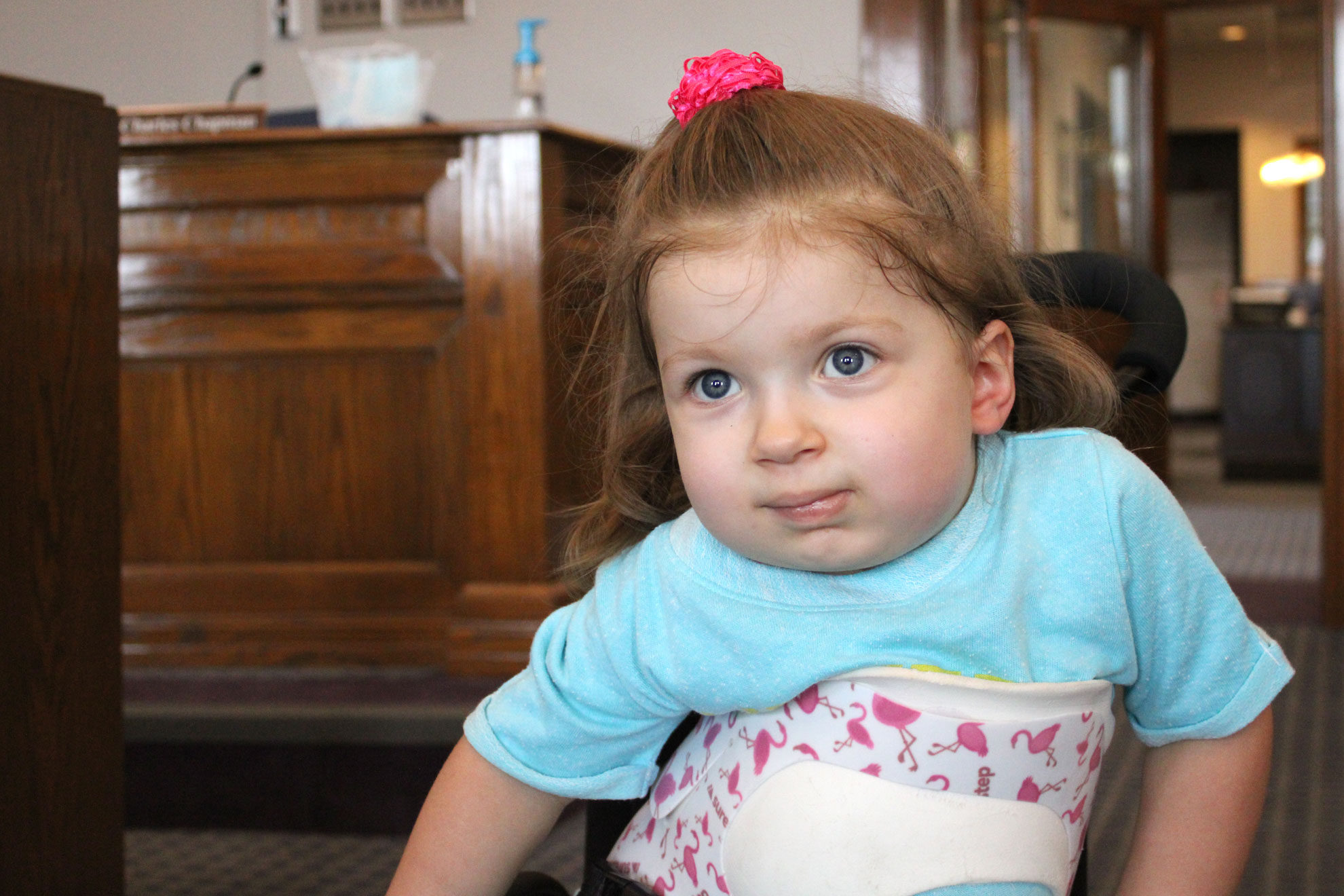Posted Tuesday, August 2, 2022.

Penny Brown, age 2, was born with a rare genetic disease. Recent advances in treatment options are helping Penny and giving families like the Browns hope.
HUNTINGTON – It’s the leading genetic cause of death in infancy, and as many as one out of every 40 American adults is a genetic carrier. One Huntington family has been coping with the hardships it presents since their daughter’s diagnosis two and a half years ago.
Thankfully, ongoing research has produced new treatments for this debilitating disease that are improving outcomes for this Huntington family and others like them – but public awareness has lagged far behind.
“I want people to know what Spinal Muscular Atrophy is,” Jessi Brown said. “We sure hadn’t heard of it before.”
As in “before” Jessi and her husband, Stephen, discovered they both are genetic carriers of Spinal Muscular Atrophy (SMA) during her pregnancy with their youngest child, Penelope. Genetic carriers do not have SMA themselves but can pass it on to their children. When both of a child’s parents are carriers, there is a high likelihood that the child will also be a carrier or have SMA.
Jessi says she and Stephen made sure to inform each of the medical professionals they interacted with after learning about their statuses as carriers. They were quickly connected with a Topeka, Ind.-based doctor who specialized in rare genetic disorders.
They learned that Penelope – or Penny as her family calls her – would have a 25 percent chance of being born with the disorder. They learned that Penny could experience severe and potentially fatal muscle weakness. They learned that, until recent breakthroughs, most children diagnosed with SMA did not make it to their second birthday.
A blood sample was collected from Penny the day after she was born after the Browns opted against prenatal SMA screening. The sample was tested by the specialist from Topeka, Ind., who confirmed Penny’s diagnosis with SMA Type 1 when she was only four days old.
SMA is caused by a mutation to the survival motor neuron gene 1 that disrupts production of a protein critical to the function of the nerves that control our muscles. Due to a lack of this protein these nerve cells eventually die, leading to the debilitating muscle weakness that characterizes SMA, according to the website curesma.org. Without treatment, it progresses quickly in many cases.
Penny started showing telltale signs of her illness within weeks of her diagnosis.
“Less than a month between the time she was born, diagnosed and treated at 24 days old she had lost quite a bit of her strength. Her arms, legs and head hardly moved. She had a weak cry and started to lose her swallow causing her to aspirate on her food,” Jessi said. “Less than a month. This is why I say days matter.”
As the Browns experienced, diagnosing SMA and starting treatment as soon as possible can make a world of difference. Between July 2020 and July 2022, the number of states routinely screening newborns for the disorder jumped from 31 to 47, according to curesma.org. Because of this 97 percent of newborn babies in the U.S. now are routinely screened for SMA, up from just 65 percent two years ago.
New treatment options have given families like the Browns hope. Penny was one of the first at Riley Children’s Hospital in Indianapolis to receive a gene therapy treatment that was approved in May 2019, her mom said. Penny also takes an oral treatment that was approved in 2020 to help boost her strength. More treatments are in the clinical development pipeline and nearing U.S. Food and Drug Administration approval.
“The last six years have been a miracle for patients with SMA, due to three new treatments being developed for this disease. Prior to 2016, patients with SMA did not have any medications that would help prevent them from getting progressively weaker,” said Dr. Marcia Felker, who provided Penny’s care at Riley Children’s Hospital. “The prognosis for patients now born with SMA and treated as babies is fantastic, with many learning to walk, and most of them breathing and eating on their own.”
Had she been born just a few years earlier, Penny most likely would have needed a ventilator and feeding tubes to survive, Dr. Felker said. Big advancements in treatment options have led to a much different outcome.
“My daughter is a regular toddler,” Jessi said. “She just can’t walk, eat or talk like a typical kid – but she has the same curiosity as one, the same desire to explore and create, and the same need to be included and to be able to experience life and wonder.”
One in every 11,000 babies in the U.S. is born with SMA, but most adults don’t know they are a carrier until their child is diagnosed with it. Finding out if you are a carrier through a blood test, even if you are done having children, can help your relatives be proactive in determining their status and knowing their risk of passing it on.
Mayor Richard Strick issued a proclamation Tuesday afternoon declaring August 2022 as Spinal Muscular Atrophy Awareness Month in Huntington, joining cities and towns across the country in recognizing it within their communities. Visit www.curesma.org to learn more about SMA or if you would like to make a donation that helps fund research and critical support services for members of the SMA community.